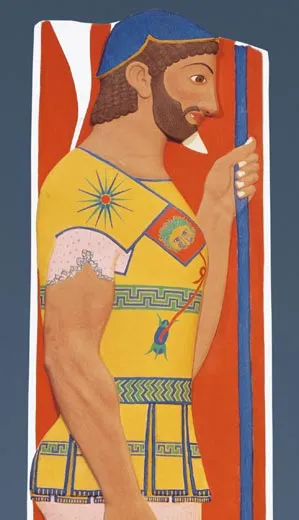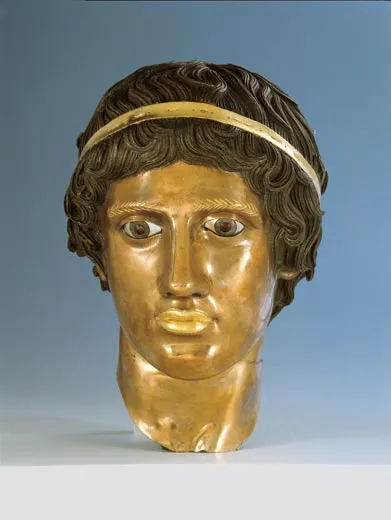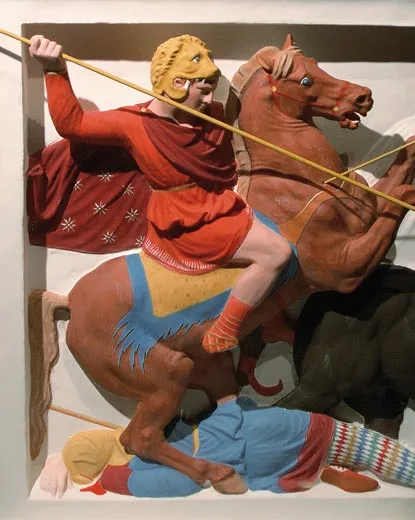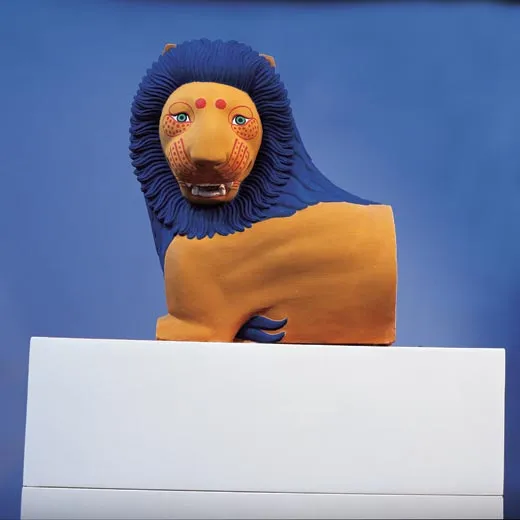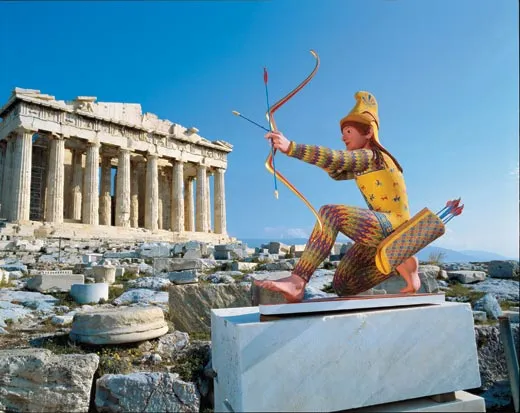True Colors
Archaeologist Vinzenz Brinkmann insists his eye-popping reproductions of ancient Greek sculptures are right on target
To find out what the Greek gods looked like, it would seem reasonable to start in Room 18 of the British Museum. That's the gallery devoted to the Elgin Marbles, grand trophies removed from the Parthenon in Athens between 1801 and 1805 by Thomas Bruce, seventh earl of Elgin, the British envoy to Constantinople from 1799 to 1803, when Greece was under Turkish domination. Even at the time, Elgin's action struck some as the rape of a great heritage. Lord Byron's largely autobiographical poem "Childe Harold's Pilgrimage" contains this stinging rebuke:
Dull is the eye that will not weep to see
Thy walls defaced, thy mouldering shrines removed
By British hands, which it had best behov'd
To guard those relics ne'er to be restored.
To this day, Greece continues to press claims for restitution.
The genius behind the Parthenon's sculptures was the architect and artist Phidias, of whom it was said that he alone among mortals had seen the gods as they truly are. At the Parthenon, he set out to render them in action. Fragments from the eastern gable of the temple depict the birth of Athena from the head of Zeus; those from the western gable show the contest between Athena and Poseidon for the patronage of the city. (As the city's name indicates, she won.) The heroically scaled statues were meant to be seen from a distance with ease.
But that was thousands of years ago. By now, so much of the sculpture is battered beyond recognition, or simply missing, that it takes an advanced degree in archaeology to tease out what many of the figures were up to. Yes, the occasional element—a horse's head, a reclining youth—registers sharp and clear. But for the most part, the sculpture is frozen Beethoven: drapery, volume, mass, sheer energy exploding in stone. Though we seldom think about it, such fragments are overwhelmingly abstract, thus, quintessentially "modern." And for most of us, that's not a problem. We're modern too. We like our antiquities that way.
But we can guess that Phidias would be brokenhearted to see his sacred relics dragged so far from home, in such a fractured state. More to the point, the bare stone would look ravaged to him, even cadaverous. Listen to Helen of Troy, in the Euripides play that bears her name:
My life and fortunes are a monstrosity,
Partly because of Hera, partly because of my beauty.
If only I could shed my beauty and assume an uglier aspect
The way you would wipe color off a statue.
That last point is so unexpected, one might almost miss it: to strip a statue of its color is actually to disfigure it.
Colored statues? To us, classical antiquity means white marble. Not so to the Greeks, who thought of their gods in living color and portrayed them that way too. The temples that housed them were in color, also, like mighty stage sets. Time and weather have stripped most of the hues away. And for centuries people who should have known better pretended that color scarcely mattered.
White marble has been the norm ever since the Renaissance, when classical antiquities first began to emerge from the earth. The sculpture of Trojan priest Laocoön and his two sons struggling with serpents sent, it is said, by the sea god Poseidon (discovered in 1506 in Rome and now at the Vatican Museums) is one of the greatest early finds. Knowing no better, artists in the 16th century took the bare stone at face value. Michelangelo and others emulated what they believed to be the ancient aesthetic, leaving the stone of most of their statues its natural color. Thus they helped pave the way for neo-Classicism, the lily-white style that to this day remains our paradigm for Greek art.
By the early 19th century, the systematic excavation of ancient Greek and Roman sites was bringing forth great numbers of statues, and there were scholars on hand to document the scattered traces of their multicolored surfaces. Some of these traces are still visible to the naked eye even today, though much of the remaining color faded, or disappeared entirely, once the statues were again exposed to light and air. Some of the pigment was scrubbed off by restorers whose acts, while well intentioned, were tantamount to vandalism. In the 18th century, the pioneering archaeologist and art historian Johann Joachim Winckelmann chose to view the bare stone figures as pure—if you will, Platonic—forms, all the loftier for their austerity. "The whiter the body is, the more beautiful it is as well," he wrote. "Color contributes to beauty, but it is not beauty. Color should have a minor part in the consideration of beauty, because it is not [color] but structure that constitutes its essence." Against growing evidence to the contrary, Winckelmann's view prevailed. For centuries to come, antiquarians who envisioned the statues in color were dismissed as eccentrics, and such challenges as they mounted went ignored.
No longer; German archaeologist Vinzenz Brinkmann is on a mission. Armed with high-intensity lamps, ultraviolet light, cameras, plaster casts and jars of costly powdered minerals, he has spent the past quarter century trying to revive the peacock glory that was Greece. He has dramatized his scholarly findings by creating full-scale plaster or marble copies hand-painted in the same mineral and organic pigments used by the ancients: green from malachite, blue from azurite, yellow and ocher from arsenic compounds, red from cinnabar, black from burned bone and vine.
Call them gaudy, call them garish, his scrupulous color reconstructions made their debut in 2003 at the Glyptothek museum in Munich, which is devoted to Greek and Roman statuary. Displayed side by side with the placid antiquities of that fabled collection, the replicas shocked and dazzled those who came to see them. As Time magazine summed up the response, "The exhibition forces you to look at ancient sculpture in a totally new way."
"If people say, ‘What kitsch,' it annoys me," Brinkmann says, "but I'm not surprised." Actually, the public took to his replicas, and invitations to show them elsewhere quickly poured in. In recent years, Brinkmann's slowly growing collection has been more or less constantly on the road—from Munich to Amsterdam, Copenhagen to Rome—jolting viewers at every turn. London's The Guardian reported that the show received an "enthusiastic, if bewildered" reception at the Vatican Museums. "Il Messagero found the exhibition ‘disorientating, shocking, but often splendid.' Corriere della Sera's critic felt that ‘suddenly, a world we had been used to regarding as austere and reflective has been turned on its head to become as jolly as a circus.'" At the Istanbul Archaeology Museum, Brinkmann's painted reconstruction of sections of the so-called Alexander Sarcophagus (named not for the king buried in it but for his illustrious friend Alexander the Great, who is depicted in its sculpted frieze) was unveiled beside the breathtaking original; German television and print media spread the news around the globe. In Athens, top officials of the Greek government turned out for the opening when the collection went on view—and this was the ultimate honor—at the National Archaeological Museum.
Taking advantage of the occasion, Brinkmann set some of his showpieces up for photographers on the Acropolis: a brilliantly colored, exotic-looking archer, kneeling with bow and arrow; a goddess smiling an archaic smile; and, perhaps most startling of all, a warrior's gilded torso in armor that clings to the body like a wet T-shirt. The figures may have looked wrong against the bleached, sun-drenched architecture, but they looked fine under the blazing Mediterranean sky.
An American showing was overdue. This past fall, the Arthur M. Sackler Museum at Harvard University presented virtually the entire Brinkmann canon in an exhibition called "Gods in Color: Painted Sculpture of Classical Antiquity." Selected replicas were also featured earlier this year in "The Color of Life," at the Getty Villa in Malibu, California, which surveyed polychromy from antiquity to the present. Other highlights included El Greco's paired statuettes of Epimetheus and Pandora (long misidentified as Adam and Eve) rendered in painted wood and Charles-Henri-Joseph Cordier's exotic Jewish Woman of Algiers of 1862, a portrait bust in onyx-marble, gold, enamel and amethyst.
The palette of these works, however, was not as eye-popping as that of Brinkmann's reproductions. His "Lion From Loutraki" (a copy of an original work dated circa 550 B.C., now in the sculpture collection of the Ny Carlsberg Glyptotek in Copenhagen) displays a tawny pelt, blue mane, white teeth and red facial markings. That exotic archer (from the original at the Glyptothek in Munich) sports a mustard vest emblazoned with a pattern of red, blue and green beasts of prey. Underneath, he wears a pullover and matching leggings with a psychedelic zigzag design that spreads and tapers as if printed on Lycra. Unlike previously proposed color schemes, which were mostly speculative, Brinkmann's is based on painstaking research.
My own introduction to Brinkmann's work came about three years ago, when I was traveling in Europe and the image of a reproduction of a Greek tombstone in a German newspaper caught my eye. The deceased, Aristion, was depicted on the stone as a bearded warrior at the height of his prowess. He stood in profile, his skin tanned, his feet bare, decked out in a blue helmet, blue shinguards edged in yellow, and yellow armor over a filmy-looking white chiton with soft pleats, scalloped edges and a leafy-green border. His smiling lips were painted crimson.
Bemused by the image and intrigued by the text that accompanied it, I e-mailed the Glyptothek in Munich. Brinkmann himself replied promptly with an invitation for a private demonstration of his methodology. We met at the museum soon after.
Brinkmann led me first to a sculpture of a battle scene from the Temple of Aphaia (c. 490 B.C.) on the island of Aegina, one of the Glyptothek's prime attractions. Within the ensemble was the original sculpture of the kneeling Trojan archer whose colorfully painted replica Brinkmann had set up for the photo shoot on the Acropolis. Unlike most of the other warriors in the scene, the archer is fully dressed; his Scythian cap (a soft, close-fitting headdress with a distinctive, forward-curling crown) and his brightly patterned outfit indicate that he is Eastern. These and other details point to his identification as Paris, the Trojan (hence Eastern) prince whose abduction of Helen launched the Trojan War.
At Brinkmann's suggestion, I had come to the museum late in the day, when the light was low. His main piece of equipment was far from high tech: a hand-held spotlight. Under "extreme raking light" (the technical term for light that falls on a surface from the side at a very low angle), I could see faint incisions that are otherwise difficult or impossible to detect with the naked eye. On the vest of the archer, the spotlight revealed a geometric border that Brinkmann had reproduced in color. Elsewhere on the vest, he pointed out a diminutive beast of prey, scarcely an inch in length, endowed with the body of a jungle cat and a majestic set of wings. "Yes!" he said with delight. "A griffin!"
The surface of the sculpture was once covered in brilliant colors, but time has erased them. Oxidation and dirt have obscured or darkened any traces of pigment that still remain. Physical and chemical analyses, however, have helped Brinkmann establish the original colors with a high degree of confidence, even where the naked eye can pick out nothing distinct.
Next, Brinkman shone an ultraviolet light on the archer's divine protectress, Athena, revealing so-called "color shadows" of pigments that had long since worn away. Some pigments wear off more quickly than others, so that the underlying stone is exposed to wind and weather at different rates and thus also erodes at different rates. The seemingly blank surface lit up in a pattern of neatly overlapping scales, each decorated with a little dart—astonishing details given that only birds nesting behind the sculpture would have seen them.
A few weeks later, I visited the Brinkmann home, a short train ride from Munich. There I learned that new methods have greatly improved the making of sculptural reproductions. In the past, the process required packing a statue in plaster to create a mold, from which a copy could then be cast. But the direct application of plaster can damage precious color traces. Now, 3-D laser scanning can produce a copy without contact with the original. As it happened, Brinkmann's wife, archaeologist Ulrike Koch-Brinkmann, was just then applying color to a laser reproduction of a sculpted head of the Roman emperor Caligula.
I was immediately taken by how lifelike Caligula looked, with healthy skin tone—no easy thing to reproduce. Koch-Brinkmann's immediate concern that day was the emperor's hair, carved in close-cropped curls, which she was painting a chocolaty brown over black underpainting (for volume) with lighter color accents (to suggest movement and texture). The brown irises of the emperor's eyes were darkest at the rim, and the inky black of each pupil was made lustrous by a pinprick of white.
Such realistic detail is a far cry from the rendering of Paris the archer. In circa 490 B.C., when it was sculpted, statues were decorated in flat colors, which were applied in a paint-by-numbers fashion. But as time passed, artists taught themselves to enhance effects of light and shadow, much as Koch-Brinkmann was doing with Caligula, created some five centuries after the archer. The Brinkmanns had also discovered evidence of shading and hatching on the "Alexander Sarcophagus" (created c. 320 B.C.)—a cause for considerable excitement. "It's a revolution in painting comparable to Giotto's in the frescoes of Padua," says Brinkmann.
Brinkmann has never proposed taking a paintbrush to an original antiquity. "No," he stresses, "I don't advocate that. We're too far away. The originals are broken into too many fragments. What's preserved isn't preserved well enough." Besides, modern taste is happy with fragments and torsos. We've come a long way since the end of the 18th century, when factories would take Roman fragments and piece them together, replacing whatever was missing. Viewers at the time felt the need of a coherent image, even if it meant fusing ancient pieces that belonged to different originals. "If it were a question of retouching, that would be defensible," Brinkmann says, "but as archaeological objects, ancient statues are sacrosanct."
A turning point in conservation came in 1815 when Lord Elgin approached Antonio Canova, the foremost neo-Classical sculptor, about restoring the Parthenon statues. "They were the work of the ablest artist the world has even seen," Canova replied. "It would be sacrilege for me, or any man, to touch them with a chisel." Canova's stance lent prestige to the aesthetic of the found object; one more reason to let the question of color slide.
In the introduction to the catalog of the Harvard show, Brinkmann confesses that even he is a relatively recent convert to the idea that the painting of statues actually constituted an art form. "What that means," he elaborates, "is that my perspective has been molded by 20th-century classicism. You can't shake that off. It stays with you all your life. Ask a psychiatrist. You have to work very hard to adjust to a new way of seeing. But I'm talking about personal feelings here, not about scholarly conviction."
Past attempts to colorize, notably by Victorian artists, were based mostly on fantasy and personal taste. Sir Lawrence Alma-Tadema's painting Pheidias and the Frieze of the Parthenon (1868-69) shows the Greek artist giving Pericles and other privileged Athenians a private tour of the Parthenon sculptures, which are rendered in thick, creamy colors. John Gibson's life-size statue Tinted Venus (1851-56) has honey hair and rose lips. One 19th-century reviewer dismissed it as "a naked impudent English woman"—a judgment viewers today are unlikely to share, given the discreet, low-key tints Gibson applied to the marble. In the United States, C. Paul Jennewein's king-size allegorical frieze of sacred and profane love on a pediment of the Philadelphia Museum of Art, unveiled in 1933, is more lavish in its use of color. The figures, representing Zeus, Demeter and other Greek divinities, are executed in showy glazed terra cotta. To contemporary eyes, the effect appears Art Deco, and rather camp.
While viewers today may regard Brinkmann's reconstructions in the same light, his sculptures are intended as sober study objects. Areas where he has found no evidence of original coloration are generally left white. Where specific color choices are speculative, contrasting color re-creations of the same statue are made to illustrate the existing evidence and how it has been interpreted. For example, in one version of the so-called Cuirass-Torso from the Acropolis in Athens (the one in which the armor appears to cling like a wet T-shirt, above), the armor is gold; in another it is yellow. Both are based on well-founded guesses. "Vitality is what the Greeks were after," Brinkmann says, "that, and the charge of the erotic. They always found ways to emphasize the power and beauty of the naked body. Dressing this torso and giving it color was a way to make the body sexier."
But the question remains: How close can science come to reproducing the art of a vanished age? There is no definitive answer. Years ago, a first generation of inquisitive musicians started experimenting with early instruments, playing at low tunings on gut strings or natural horns, hoping to restore the true sound of the Baroque. Whatever the curiosity or informational value of the performances, there were discriminating listeners who thought them mere exercises in pedantry. When the next generation came along, period practice was becoming second nature. Musicians used their imagination as well as the rule books and began making music.
Brinkmann ponders the implications. "We're working very hard," he says. "Our first obligation is to get everything right. What do you think? Do you think some day we can start making music?"
An essayist and cultural critic based in New York City, author Matthew Gurewitsch is a frequent contributor to these pages.
